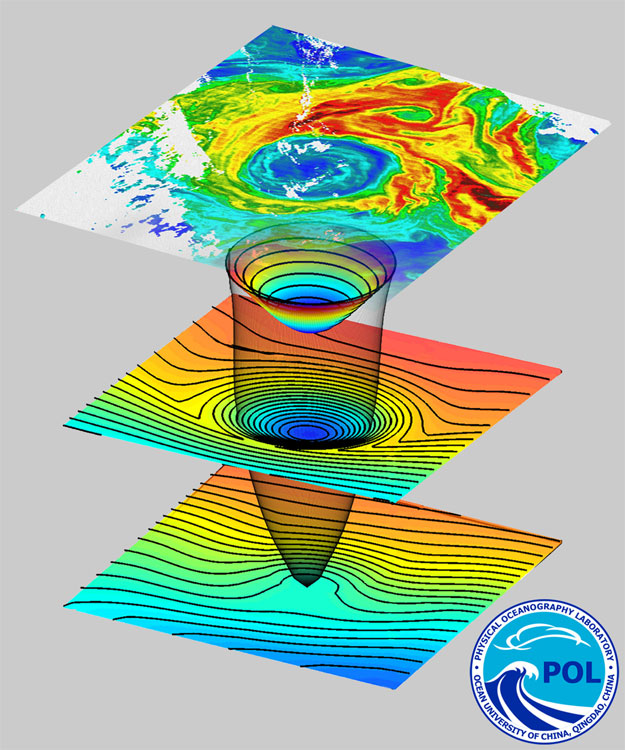.
The weather is a dance between an odd couple: the frantic atmosphere and the staid sea. The atmosphere changes quickly, as when a strong wind suddenly starts to blow or a cyclone careens ashore. The ocean seems more sedate. Its wide gyres trace the edges of continents, carrying sun-warmed water from the equator out towards the poles. Even the rough storms that terrorize sailors are more the sky’s fault than the sea’s. The waves that toss a ship are whipped up by the wind.
But it turns out that the ocean makes its own gestures; it just makes them very slowly. Enormous vortices of water, measuring 60 miles across, spin their way across the sea at a deliberate pace—3 miles per day. Oceanographers have dubbed them mesoscale eddies for their middle size, larger than a wake formed by an aircraft carrier and smaller than a gyre. Each one is like an upside down mountain of water, held together by its own rotation and extending about 3,000 feet beneath the surface. In the video above, eddies show up as red and blue dots dancing around. (Red ones spin clockwise, blue ones counterclockwise.) Just how much water gets carried around by all these eddies? The total is staggering: more than 30 times the amount dumped by all the world’s rivers into the ocean, according to a paper published today in Science. Other stuff gets caught in the vortices and taken along for the ride. This huge network of eddies may be shipping packets of pollutants, organic nutrients, and dissolved carbon all around the world.
.

Enormous ocean eddies are measured using satellites (height map, top layer) and submersibles (vorticity map, bottom layers).
Ocean University of China
.
These eddies are almost invisible unless you look from space. For decades, oceanographers have been tracking eddies using NASA satellites. By bouncing a pulse of radar off the surface of the water and recording the time it takes to return, the satellites can measure their distance from the water to within less than an inch. This astounding accuracy turns out to be necessary, since unlike the deep ship-swallowing whirlpools of Greek mythology, the depression at the center of an eddy is a mere 20 inches.
To reconstruct the 3-D structure of the eddies and find their volume, a team of oceanographers led by Bo Qiu of the University of Hawaii used data from underwater floats. More than 3,000 ARGO submersibles are scattered around the globe, lurking under the surface. Each comes to the surface every 10 days to report the water temperature, salt content, density, and velocity. An eddy, once born, might travel for months or years before dissipating. By combining a decade of satellite and submersible data, the researchers were able to track the incredible mass of water collectively moved by eddies across the entire world. Qiu’s calculations surprised even him.
“We didn’t expect the number to be that high,” he said. “We know they propagate westward, and there are a lot of eddies. But the mass… there’s an order of magnitude more than we expected.”
Previously, it was thought that the steady currents like the Gulf Stream were almost entirely responsible for moving stuff through the ocean. The ocean transports trash, nutrients, radioactive waste, dissolved carbon dioxide and heat all around the world, and the latter two are especially important for understanding climate change. Qiu’s study raises the possibility that eddies also make a substantial contribution to these transports.
This paper will kick off a wave of research among climate modelers, says Ryan Abernathey, who studies the impact of ocean circulation on climate at Columbia University. ”The volume estimate is really surprising,” he said. “This is an important effect. The next question is how leaky the eddy is.” The eddy is made of water, after all, and the difference between inside and outside is not precise. If, say, the dissolved carbon caught in an eddy slowly slips out, then after a year of meandering an eddy may have left its original contents an ocean away. But if the eddies hold their cargo tightly, they might be shipping enormous packages of carbon, salt, and pollutants from Australia to Africa and from Europe to America. Scientists are now trying to figure out how the packages effect local ecosystems and the planet’s climate.
Quelle: WIRED
4466 Views

